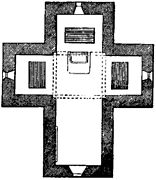Mausoleum of Galla Placidia
The Mausoleum of Galla Placidia in Ravenna (Italy) is a famous monumental burial of the sister of the Emperor Honorius, Galla Placidia. Built between 425 and 430, it is one of the eight structures in Ravenna inscribed on the World Heritage List in 1996. More than for its architecture, this monument is world famous for its sumptuous mosaics, the oldest in the town. They mark the transition between early Christian and Byzantine art. As UNESCO experts pointed out, "it is the oldest and best preserved of all mosaic monuments, and at the same time one of the most artistically perfect."
Architecture
The mausoleum has a floor plan in the shape of a Greek cross, with the main nave being longer than the transept. The building was attached to the narthex of the missing Church of the Holy Cross. It is a funerary building, although it also has a martyrdom character, because it was later dedicated to San Lorenzo.
Regarding its external appearance, it presents a very classic appearance: brick and stone masonry joined by mortar. The building has blind arches to the outside, and a roof covered with flat tégula pouring four waters in the central body and two waters on the sides.
Its great innovations can be appreciated in the interior and in the shape of the plant: its transept is closed with a hollow dome without lining, and with barrel vaults on the sides. The walls are decorated with rich mosaics. The dome is also covered in mosaics, depicting eight of the apostles and symbolic figures of doves drinking from a vessel. The other four apostles are represented in the vaults of the transverse nave; Above the door there is a representation of "Celestial Pastoral", that is, of Jesus Christ as the Good Shepherd, young, beardless, with wavy hair, and surrounded by sheep; on the opposite side, there is a subject that is interpreted as the representation of San Lorenzo. Thin, translucent stone panels allow light into the structure through the windows. All its decoration and sarcophagi are preserved.
The decoration (based on Christian motifs) has an important symbolism, presenting plant themes (evoking paradise) combined with geometric and figurative decoration (martyrs, apostles, angels, etc.). The apse is decorated with a starry sky with angels in the corners. The mosaics contain gold dust in the glass mix. This can be observed by looking at a certain angle at the ceiling.
The building (formerly the oratory of a larger church dedicated to the Holy Cross) contains three sarcophagi; the largest of them is said to be that of Galla Placidia, and that her embalmed body was deposited here in a seated position, dressed in the imperial mantle; in 1577, however, the contents of the sarcophagus were accidentally burned. The sarcophagus on the right is attributed to Emperor Valentinian III or Galla Placidia's brother, Emperor Honorius. The one on the left is attributed to Galla Placidia's husband, Emperor Constantius III.
Contenido relacionado
1031
497
432




